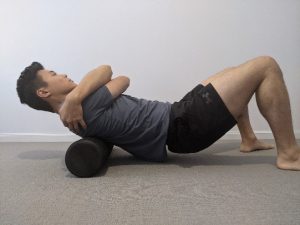Does Foam Rolling Work?
Longevity Exercise Physiology and Personal Training Edgecliff, Lindfield, Marrickville, Randwick, Drummoyne, Balmain and Bella Vista look at what foam rolling can do for your health.
If you’ve heard of exercise, you’ve most likely seen these things as well:

These things are foam rollers and you’ve probably seen people rolling their bodies all over them at the gym. Foam-rolling is a self-myofascial release technique, which is just a fancy way of saying that you’re giving yourself a massage. So you might be wondering, what does this actually do?
The common idea seems to be that foam rolling can enhance performance and flexibility, as well as alleviate muscle soreness and fatigue. But how much of this is true?
Let’s have a look at the things that foam rolling CAN do:
1. Reduce perceptions of pain and muscle soreness
This can be especially useful if pain is limiting your movement during exercise or daily activities. However, as there are many types of pain, consult with your exercise physiologist before trying to foam roll. A popular theory is that the direct application of pressure on muscles from foam rolling triggers a neural mechanism that inhibits nociceptive (relating to pain or danger) signals from the body for short-period of time.
Several studies have shown that foam rolling an area of muscle for at little as 30 seconds can increase joint range of motion without a decrease in muscular performance, as you would see with longer periods of static stretching
2. Improve flexibility temporarily without reducing muscle performance
Several studies have shown that foam rolling an area of muscle for at little as 30 seconds can increase joint range of motion without a decrease in muscular performance, as you would see with longer periods of static stretching (e.g. more than 60s per muscle). This is not to say that foam rolling is better than stretching, as Samson, 2012 demonstrated that performance reductions can be completely avoided if one performs a general warm-up routine right after stretching.
3. Increase blood flow to muscles
This ties into point number 2, where increased blood flow to tissues enhances flexibility and range of motion temporarily. It serves another reason why someone may choose to foam roll before a workout, as this not only prepares muscles for work, but also may play a role in reducing soft tissue injuries during exercise (although no studies have directly shown a reduction of injuries due to foam rolling). Recent research has also shown a link to reduced arterial stiffness and improved vascular endothelial function, which are factors of cardiovascular health—but only in the short-term.
- Improve sprint performance slightly
Studies have shown that foam rolling prior to sprinting can create a small improvement in performance. When used as a recovery tool after exercise, it can also slightly reduce decrements in sprint and strength performance. However, there is no evidence that it can elicit improvements in any other modes of exercise.
Now, these are the things foam rolling CAN’T do:
1. Loosen up muscle knots, adhesions or break up scar tissue
A common reason for foam rolling is to ‘loosen up’ tight spots of muscle as if we were rolling out pizza dough. Knots, adhesions and scar tissues are terms that are often used interchangeably, although they actually have different clinical definitions. However, they are common in that they are mainly collagen fibers in our bodies that have become stiff and rigid as a result of overuse, poor postures, or when tissues sense nearby joints need additional stability. Therefore, it is a lack of motion or directional force that drive tissues towards stiffness.
This means that we need MOTION or FORCES (i.e. exercises) that let tissues move in the correct direction to reverse stiffness, not a passive activity like foam rolling. In fact, collagen is proportionally stronger than steel cable. Studies have also shown that “conventional myofascial release (i.e. foam rolling) was unable to produce meaningful deformation of thicker fascial tissues (mostly comprised of collagen fibers).
- Improve general muscle strength, endurance or power
Simple as that; foam rolling before your workout will not let you lift heavier, run faster or exercise for longer. When you are implementing an exercise routine, it will be necessary to perform a targeted warm-up that primes muscles for the activity.

Overall, the benefits of foam rolling are mostly short-term and is by no means going to give you long-term health outcomes, no matter how often you do it. Nonetheless, it is an effective tool to implement into your warm-up routine due to the benefits we talked about—just remember to keep it short, sweet and definitely don’t make it the only thing you do during your warm-up. To find out how to add foam rolling effectively into your warm-up, as well as what else your warm-up should consist of, speak to one of our Exercise Physiologists today!
Contact Longevity Personal Training and Exercise Physiology Edgecliff, Lindfield, Marrickville, Randwick, Drummoyne, Balmain, Bella Vista on 1300 964 002 to enquire today about how you can use foam rolling in your exercise program.
Written by Jackie Cheung

References
Chaudhry, H., Schleip, R., Ji, Z., Bukiet, B., Maney, M., & Findley, T. (2008). Three-Dimensional Mathematical Model for Deformation of Human Fasciae in Manual Therapy. The Journal Of The American Osteopathic Association, 108(8), 379. doi: 10.7556/jaoa.2008.108.8.379
M, S., DC, B., A, C., & DG, B. (2020). Effects of dynamic and static stretching within general and activity specific warm-up protocols. Retrieved 21 November 2020, from https://pubmed.ncbi.nlm.nih.gov/24149201/
Okamoto T., Masuhara M., Ikuta K. (2013). Acute effects of self-myofascial release using a foam roller on arterial function. Journal of Strength and Conditioning Research. 28:1:69-73.
Wiewelhove, T., Döweling, A., Schneider, C., Hottenrott, L., Meyer, T., Kellmann, M., . . . Ferrauti, A. (2019). A Meta-Analysis of the Effects of Foam Rolling on Performance and Recovery. Frontiers in Physiology, 10(376). doi:10.3389/fphys.2019.00376
